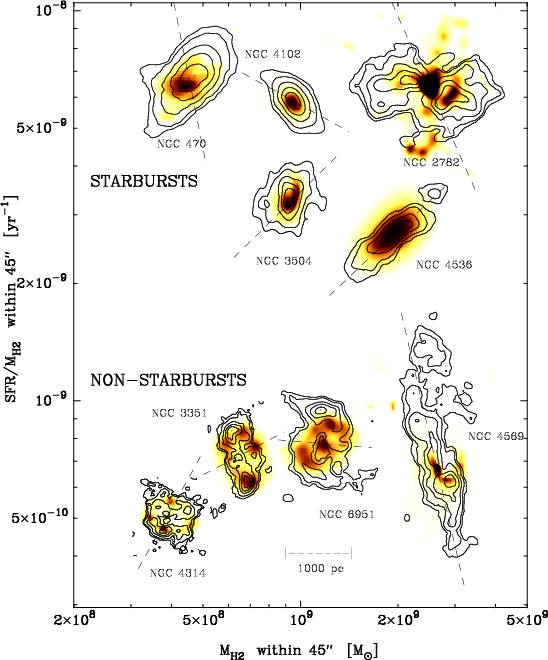The Central regions of Barred Galaxies: Molecular Environment, Starbursts,
and Secular Evolution
The central kpc of galaxies hosts active galactic nuclei (AGN),
super star clusters (SSCs), spectacular starbursts,
and can often produce the bulk of the IR luminosity.
My research revolves around the theme of understanding evolution in the
central kpc of nearby galaxies, with particular focus on starbursts
and AGN,as a stepping stone towards understanding ultra luminous galaxies (ULIRGs)
and high redshift galaxies. We have conducted at OVRO
a high resolution (100 pc) interferometric CO (J=1--0) survey of
molecular gas in the inner kpc of eleven circumnuclear starbursts and
non-starbursts (Jogee 1999; Jogee, Kenney, & Scoville 2002).
Molecular gas differs markedly in the inner kpc and the outer disk
In the inner kpc, the Toomre (1964) critical density for the onset of
gravitational instabilities which can help agglomerate
molecular clouds into complexes is very high
(few 100-1000 M_sun pc-2) because of the large Coriolis and pressure forces.
However, the growth timescale of
gravitational instabilities in the inner kpc is short (a few Myrs)
and comparable to the lifetime of OB stars which destroy
molecular clouds.
This may lead to an increase in the fraction
of gas converted into stars before cloud disruption.
Another special feature of the inner kpc is
the presence of a
high pressure, high turbulence molecular ISM.
Such an ISM may favor the formation of more
massive clusters (e.g., Elmegreen et al. 1993) and may explain why
bright SSCs in non-interacting spirals
tend to occur preferentially in the inner kpc.
I investigate why the circumnuclear starbursts
have a higher star formation efficiency (SFE or SFR per
unit mass of molecular gas) in the inner kpc than the non-starbursts.
We find evidence suggesting that starbursts
develop super-critical densities close to the center,
while sub-critical densities and large shear inhibit
star formation in non-starbursts.
I find that
many ULIRGs host starbursts whose molecular ISM has
scaled-up densities and linewidths in comparison with
local starbursts and this may result in a larger star formation efficiency.
Such a dense turbulent molecular ISM can be build up
through major mergers.
For details see
Jogee, Scoville, & Kenney 2005 (astro-ph/0402341):
The Central regions of Barred Galaxies: Molecular Environment, Starbursts,
and Secular Evolution (ApJ 2005)
Jogee, S. 2001 (astro-ph/0201202):
Starbursts: Triggers and Evolution

